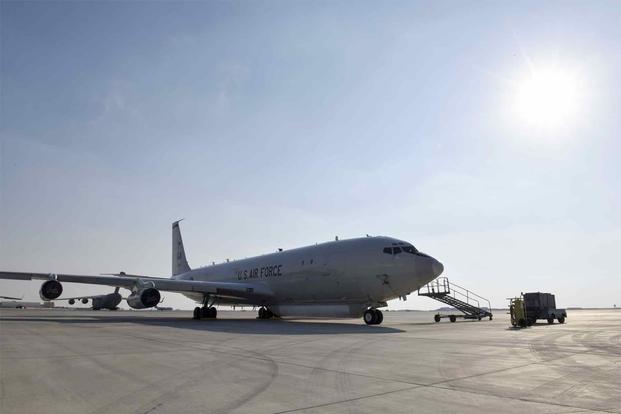Just as mission planners thought it was out, the Joint Surveillance Target Attack Radar System (JSTARS) was recently pulled back into the Middle East.
The Air Force said the E-8C JSTARS aircraft had its sunset mission in the U.S. Central Command area of responsibility in October, but the aircraft -- capable of developing, detecting, locating and tracking moving targets on the ground -- was spotted back at Al Udeid Air Base, Qatar, on Jan. 16, according to Air Forces Central Command.
Its arrival came amid heightened tensions between the U.S. and Iran just one week after the Jan. 8 Iranian ballistic missile strike on Al Asad Air Base in Iraq, which houses U.S. troops.
AFCENT noted the aircraft "provides commanders with vital intelligence, surveillance and reconnaissance capabilities to help maintain security and stability in the region" but did not say long it would remain in the region.
Since its return, JSTARS have conducted missions in support of Operation Sentinel Sentry and Spartan Shield, said Maj. Ashleigh Peck, spokeswoman for Al Udeid's 379th Air Expeditionary Wing. The operations are an effort to protect U.S. and allied interests in the Middle East.
"The aircraft flew 13 sorties, including 106 combat support flying hours in support of operations in the Arabian Gulf," Peck said in an email. "The posture of forces at Al Udeid Air Base may fluctuate based on operational requirements and regional threats."
Related: After 18 Years, JSTARS Surveillance Plane Is Coming Home from the Middle East
The aircraft began deploying to the Middle East in November 2001. Shortly after, service officials saw demand surge for the aircraft; as a result, the Air Force in 2002 assembled the first total force initiative wing, or "Team JSTARS," at Robins Air Force Base, Georgia. The 16-aircraft fleet resides there.
The airborne command-and-control plane, a modified Boeing 707-300 series commercial airframe that can fly as high as 42,000 feet, is "extensively remanufactured and modified with the radar, communications, operations and control subsystems," including a prominent 27-foot bathtub-like radome under the fuselage, according to the Air Force.
While the E-8 will still fly into the mid-2020s, military officials have looked for alternative solutions to provide the same capabilities.
Proponents have pointed to the next-generation Advanced Battle Management System (ABMS), an elite network that will fuse intelligence, surveillance and reconnaissance sensor data from around the world, as being more sophisticated and more survivable, especially since it can't be shot down.
The service originally planned to buy 17 new JSTARS in coming years, but leaders officially put that recapitalization effort to bed in favor of the ABMS in the fiscal 2019 defense budget request.
Editor's Note: This story has been updated with comment from the 379th Air Expeditionary Wing.
-- Oriana Pawlyk can be reached at oriana.pawlyk@military.com. Follow her on Twitter at @Oriana0214.
Read more: 2 Navy Jets Fly Like Drones in First-of-Its Kind Experiment












